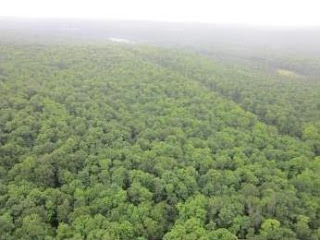The open pit mine will be located along the Kipawa River near Brennan (Sairs) Lake and Sheffield Lake. Rejects and tailings storage will occur on site. Exact location of these facilities has not yet been determined but potential sites appear to be wetland areas located within the Kipawa Watershed. Three potential sites for tailings storage were identified.
Potential tailings storage sites:
Aerial Views of Potential Tailings Storage Sites
The radioactivity, leachability and acid generation potential of the rejects and tailings have still not been determined. There will be two waste rock piles with a capacity of 28 metric tonnes and an elevation of 365 meters.The tailings and reject storage sites will have a capacity of 20.4 metric tonnes. The rejects will be piled and a drainage system will be implemented to collect water, the details on this system are not yet available. The tailings storage will be lined with a geomembrane and confined by a dike, exact specifications of the tailing storage and methods to prevent contamination to surrounding areas are not yet available.
A significant amount of waste water will be produced. Waste water will include mine water, run off from waste rock piles, tailings site, rejects site, industrial site as well as process water. The discharge points of this waste water and treatment methods, if any, are not yet available. Water will enter the open mine pit via precipitation, infiltration, it along with other waste water will be pumped into a sedimentation pond. A trench system will be installed around the open pit, waste rock piles, rejects site to direct water to the sediment pond. Water from the sediment pond will be discharged to nearby water bodies, exact locations have not yet been determined. Information on treatment of this waste water prior to discharge is not available. It will only be carried out if necessary to comply with environmental laws. It is important to note that rare earth mining has never been carried out in Canada. The Metal Mining and Effluent Regulations are not designed to manage the environmental risks of this type of mining. These laws do not regulate all of the substances that could be released during rare earth mining. An additional effluent will be installed from the water that is spilt on the tailings site, the location of this discharge point has not yet been determined.
Fresh water intakes will be required for the mine as well as the plant. Water use is estimated at 190-210 meters cubed of freshwater per hour. The exact location of draw for this freshwater has not yet been determined. Dust will be released during blasting, ore crushing, milling and transportation by truck. Changes to existing forestry roads and new access roads will be required including a bridge over the Kipawa River. The rare earth concentrate will be transported to Temiscaming via truck and then by rail to ports on the Pacific Coast or St. Lawrence for shipping to Asia or Europe. It is estimated that two containers of concentrate will be produced per day.
Processing the ore involves crushing, milling, magnetic separation, leaching using strong acids, rinsing and neutralizing using strong bases, such as Lime. These strong acids and bases will be transported to the processing facility by truck from Ontario via HWY 63 and the Maniwaki Road, putting other watersheds at risk should an accident or truck roll over occur. Wastes generated during the processing of the ore will remain on site in the reject rock piles, tailings sites or released into the Kipawa watershed as effluent.
 |
| Processing Plant Location |
 |
| Aerial View of Processing Plant Location |
 |
| This forest will be replaced by the open Pit Rare Earths Mine |
 |
| Details of the ore processing procedures |
For more information please visit:
http://www.miningwatch.ca/article/rare-earth-elements-background-information
http://www.ceaa.gc.ca/050/details-eng.cfm?evaluation=80029
Please sign and share the petition
Join the conversation on Facebook
Follow on Twitter







No comments:
Post a Comment